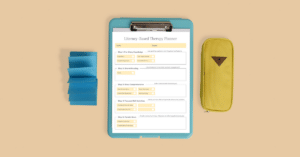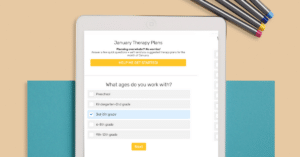A few months ago, I began exploring the possibility of doing teletherapy. It’s such a different service delivery model than what I’m used to. My first question was, “How am I going to adapt my materials to make them work for teletherapy?” My background is working in the schools, so it made me consider how I could continue to utilize my membership tools and materials in this new format.
We have had so many people reach out lately asking the same question… How can the SLP Now membership be used for teletherapy?
A previous blog post answered commonly asked questions about getting started with teletherapy.
Today’s post is all about digging into more specific tips and ideas for teletherapists. Tracy Sippl from S&L Teletherapy Consulting was kind enough to return to share her valuable insight as an SLP Now member and an experienced teletherapist.
1. How long have you been doing teletherapy? What population do you work with?
I worked onsite (in schools) for 24 years, and then for the last six years, I have been providing services via telepractice. I work with Pre K-12th grade on articulation, language, phonological, fluency, pragmatics and nonverbal (ASD population), hearing impaired, etc.
2. How do the SLP Now caseload management tools help you stay organized or increase efficiency throughout the day?
I find the easier it is to consolidate my client information, the more streamlined my performance. This translates into being organized and being able to be as efficient as possible based on my caseload’s needs. Not having to shuffle through papers to enter/retrieve notes taken during a session is a HUGE timesaver in and of itself! While providing teletherapy, everything is computer-based, from the materials to the treatment. Why should the calendar and note-taking be any different? Again, to have the information available online and in one area is ideal.
3. What platform do you use, and how are you able to utilize its features to make the materials interactive with your students?
I have used a number of different platforms over the years, but the two that I currently use the most are TheraWeb (through Therapy Source, Inc.) and Zoom (my teletherapy consulting business). Both are user-friendly and offer the tools I need. Since most, if not all, of the SLP Now materials are in a PDF format, they are ready to be uploaded into my students’ virtual classrooms while using TheraWeb. There, I can pull up the materials I’ve saved for each student in his/her own private virtual classroom to address the skill targeted for that day. The students can type the answers onto the actual documents, use the drawing tools to circle correct answers, color items, etc. While using Zoom, all I need to do is screenshare the document with my student, and s/he can interact with the material in the same manner. In terms of the crafts that come with some of the units, I like to assign those as speech-language homework, having the student take the instructions home to complete with his/her parents. This typically leads to discussion about what was worked on in speech-language therapy that day, which is the intent.
4. What materials do you use most? Can you give an example of how you might use them in a teletherapy session?
I became a member once I discovered Marisha’s website in 2015. During an ASHA Convention in 2016, I met Marisha at her booth and explained how I found her materials to be a huge timesaver. At that time, I used the bundles and continue to use them today. I wanted to find a way to create language materials that were literature-based, but I just couldn’t find the time to do it. Voila! Marisha did it for me. My students enjoyed interacting with the materials, which meant keeping them engaged was less of an issue.
Scenario: I am working with a first-grade student whose goal focuses on curricular vocabulary. I like to use themes, and the class happens to be discussing bugs. I type that in the search under “Themes.” I am presented with a variety of resources to draw from. I tend to download the book guide and book activity bundles and decide from there what pages to use for each client in that group (or individually). I have worked with students that are schooled at home through a virtual public-school system (virtual academy), as well as students located in a brick-and-mortar setting that have a tele-helper nearby to assist with cutting/pasting/coloring/crafts. Both types of students have benefited from the use of these materials.
5. Can you describe what literacy-based therapy looks like in a teletherapy session?
I tend to use digital copies of materials if I can find them online. I love the website Epic Books for Kids because they have most of the popular classics, as well as newer children’s books online. If I need to use a hard copy of a book, then I pull out my document camera that allows the student to see the pages as if standing next to me looking down and reading.
While implementing a literacy-based approach, I like to align parts of the story worksheets. Depending on the age of the student, I will teach strategies for predicting, inferencing, summarizing, identifying the main idea, etc., and I will use the SLP Now materials to practice these skills. Then, I will use a book I chose and the materials Marisha has available that correspond with a book of choice to put those newly learned strategies to use (e.g., generalization of skills; carryover).
6. Any advice for a therapist transitioning from a physical school or clinic setting in terms of how they might need to make adjustments with how they access and/or use the materials?
You can use hard copies with a document camera and screen share using the tools available to interact with the material, but in the long run, I think it would be easier to download them as needed. Keep in mind that there are tricks to organizing the materials for easier access. I typically set up a folder for the school my students attend and create folders for each of my students I see individually (or for each group). If you have hard copy materials you’ve accumulated over time, then you can scan those in using a copier/scanner and upload them to your computer to use when necessary. When I do my therapy planning, I create shortcuts for the materials I want to use with a particular student/group and place those shortcuts in that student’s/group’s file folder that I previously created. I may even create a subfolder under that student’s/group’s folder, labeling it with the date I plan on using those materials.
(You can also attach materials to a session in the SLP Now membership! Click here to see the entire process in action.)
7. Any additional tips you’d like to share?
I think the blog posts and videos discussing and/or demonstrating how to use the materials are very helpful. If I am looking for additional inspiration, I can watch a video or refer to an associated blog post. I use that information to help me generate even more ideas about how I can integrate materials into my teletherapy sessions.
A huge thanks to Tracy Sippl for sharing her experience with us today!
Are you a teletherapist? Do you have any favorite strategies or tools? Let us know in the comments below!






Reader Interactions